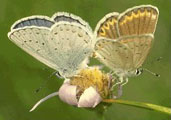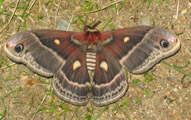Native Plants
Search for native plants by scientific name, common name or family. If you are not sure what you are looking for, try the Combination Search or our Recommended Species lists.
Kalmia angustifolia
Kalmia angustifolia L.
Sheep Laurel, Lambkill Kalmia, Lambkill
Ericaceae (Heath Family)
Synonym(s):
USDA Symbol: KAAN
USDA Native Status: L48 (N), CAN (N), SPM (N)
A dense shrub growing 3+ ft. tall and usually twice as wide. An evergreen shrub with small, deep pink, saucer-shaped flowers in dense clusters around stem, mostly below leaves. Some stems may trail on the ground ending in erect branch tips. The glossy, narrowly-oval, leathery leaves are blue-green and turn reddish-green to purple in fall. The flower is a small, purple to red bell, scattered in clusters along the stems.
Because of its colonial habit, Sheep Laurel can form sizable stands. The flowers are miniatures of the larger Mountain Laurel (K. latifolia). Pale Laurel (K. polifolia), also known as Bog Laurel, has pink flowers in terminal clusters, 2-edged twigs, and opposite leaves with rolled edges, very white beneath; it is a northern bog plant and occurs only as far south as northern New Jersey and Pennsylvania. Two other species of Kalmia are found in the southern United States. The genus name honors Peter Kalm, a student of Linnaeus, who traveled and collected plants in the Americas in the 18th century.
Plant Characteristics
Duration: PerennialHabit: Shrub
Root Type: Tap
Leaf Retention: Evergreen
Leaf Complexity: Simple
Leaf Shape: Elliptic
Breeding System: Flowers Bisexual
Fruit Type: Capsule
Size Notes: Up to about 5 feet tall, often shorter.
Leaf: Green above, pale green below
Flower: Flowers 3/8 inch
Fruit: Brown
Bloom Information
Bloom Color: White , Red , Pink , PurpleBloom Time: May , Jun , Jul
Bloom Notes: Usually reddish purple to pink, rarely white or bluish pink.
Distribution
USA: CT , DC , DE , MA , MD , ME , MI , NH , NJ , NY , PA , RI , VA , VT , WVCanada: MB , NB , NS , PE
Native Distribution: Lab. to Ont., s., primarily through e. portion of e. states, to GA; also n. MI
Native Habitat: Wet or dry pastures & thickets; swamp & bog borders; wooded stream banks
Growing Conditions
Light Requirement: Part ShadeSoil Moisture: Wet
Soil pH: Acidic (pH<6.8)
Soil Description: Wet/organic to dry/sterile soils.
Conditions Comments: Will develop chlorosis caused by iron deficiency if located on limy soils. Slow-growing. Dead-heading encourages better blooms in the following years.
Benefit
Use Wildlife: Low.Warning: POISONOUS PARTS: All parts. Highly Toxic, Maybe Be Fatal if Eaten! Symptoms include: salivation, watering of eyes and nose, slow pulse, nausea, vomiting, sweating, abdominal pain, headache, tingling of skin, lack of coordination, convulsions, paralysis. Toxic Principle: Andromedotoxin, a resinoid; arbutin, a glycoside. (Poisonous Plants of N.C.)
Sheep Laurel has another common name, lambkill"", referring to the fact that this plant is poisonous to sheep and domestic cattle, althought it apparently has no effect on deer. (Strickland)"
Conspicuous Flowers: yes
Attracts: Birds , Butterflies
Larval Host: Columbia silkmoth, Northern Blue butterfly (Lycaeides idas).
Butterflies and Moths of North America (BAMONA)
|
Northern Blue (Plebejus idas)  Larval Host |
Columbia silkmoth (Hyalophora columbia)  Larval Host |
Propagation
Seed Collection: Seeds are tiny and mature late.Commercially Avail: yes
Find Seed or Plants
View propagation protocol from Native Plants Network.
Mr. Smarty Plants says
Plant identfication
October 21, 2009
Hi...Can you please identfy the tall, evergreen shrub with purple plum-colored foliage that I have noticed in winter locally?...Hope so, need he color! THX
view the full question and answer
Evergreen shrubs for Michigan
June 17, 2008
I'm seeking a small-medium, ornamental, fairly compact, evergreen shrub to complement my front yard woodland wildflower garden. I want a shrub that will flank both sides of my front porch steps. I wa...
view the full question and answer
National Wetland Indicator Status
| Region: | AGCP | AK | AW | CB | EMP | GP | HI | MW | NCNE | WMVE |
| Status: | FAC | FAC | FAC |
From the National Organizations Directory
According to the species list provided by Affiliate Organizations, this plant is on display at the following locations:Delaware Nature Society - Hockessin, DE
Mt. Cuba Center - Hockessin, DE
Bibliography
Bibref 1186 - Field Guide to Moths of Eastern North America (2005) Covell, C.V., Jr.Bibref 1185 - Field Guide to Western Butterflies (Peterson Field Guides) (1999) Opler, P.A. and A.B. Wright
Search More Titles in Bibliography
Web Reference
Webref 38 - Flora of North America (2019) Missouri Botanical Garden, St. Louis, MO & Harvard University Herbaria, Cambridge, MA.Webref 23 - Southwest Environmental Information Network (2009) SEINet - Arizona Chapter
Additional resources
USDA: Find Kalmia angustifolia in USDA PlantsFNA: Find Kalmia angustifolia in the Flora of North America (if available)
Google: Search Google for Kalmia angustifolia
Metadata
Record Modified: 2023-02-15Research By: TWC Staff